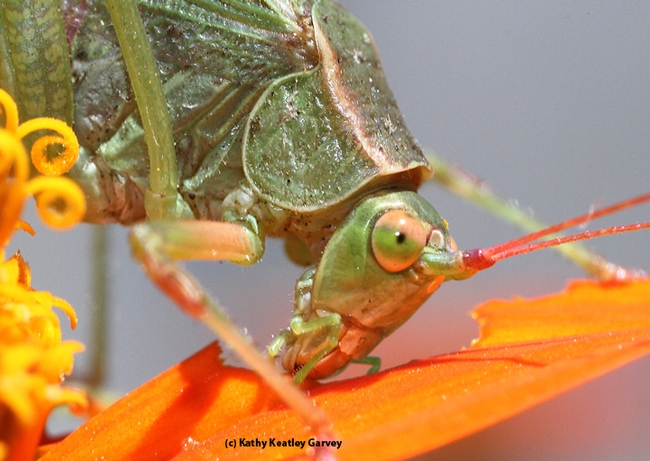I've always rather liked katydids.
Anyone who is called "Kate" or "Katy" in their childhood usually winds up with "Katydid" as a nickname. And they repeatedly hear "Katy did. Katy didn't" (the sound the insect makes).
So when a katydid appeared on our Mexican sunflower (Tithonia) this morning, yours truly (once a Kate and a Katydid) grabbed a camera.
Up close, they look like prehistoric animals, a mini version of the huge dinosaurs that roamed the earth 245 million years ago.
From the family Tettigoniidae and the order Orthoptera (grasshoppers, crickets and katydids), they're found throughout the world except in Antarctica. Sometimes katydids are called long-horned grasshoppers or bush crickets.
Fruit growers know the katydids as pests. They scar fruit such as citrus, taking a bite from one and moving onto the next. You can imagine what that does to the market value.
The UC Statewide Integrated Pest Management Program (UC IPM) provides information about the forktailed bush katydid: (Scudderia furcata) and the angularwinged katydid (Microcentrum retinerve) in its Citrus Pest Management Guidelines: "Of the two species feeding on citrus, only the forktailed katydid causes economic damage. This species feeds on young fruit at petal fall with subsequent buildup of scar tissue and distortion of expanding fruit. Katydids take a single bite from a fruit and then move to another feeding site on the same or nearby fruit. In this way, a few katydids can damage a large quantity of fruit in a short time. They also eat holes in leaves and maturing fruit, creating injury that resembles damage by citrus cutworm. The angularwinged katydid is less abundant than the forktailed katydid and feeds only on leaves."
Katydids also damage such fruits as pomegranates, pears, peaches, plums and apricots.
"Our" little katydid fed on the petals of the Tithonia, stopping occasionally to look at the photographer.
Katy did and then Katy didn't.
Attached Images:

A camouflaged katydid, its body resembling a leaf, feeds on a Mexican sunflower, Tithonia. (Photo by Kathy Keatley Garvey)

The katydid bends to feed on a Tithonia leaf. (Photo by Kathy Keatley Garvey)

Close-up view of a katydid. (Photo by Kathy Keatley Garvey)

The katydid continues to feed. (Photo by Kathy Keatley Garvey)